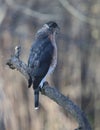Cooper's hawk (Accipiter cooperii) is a medium-sized hawk native to the North American continent and found from southern Canada to Mexico. A pellet, in ornithology, is the mass of undigested parts of a bird's food that some bird species occasionally regurgitate. The contents of a bird's pellet depend on its diet, but can include the exoskeletons of insects, indigestible plant matter, bones, fur, feathers, bills, claws, and teeth. In falconry, the pellet is called a casting.The passing of pellets allows a bird to remove indigestible material from its proventriculus, or glandular stomach. In birds of prey, the regurgitation of pellets serves the bird's health in another way, by "scouring" parts of the digestive tract, including the gullet. Pellets are formed within six to ten hours of a meal in the bird's gizzard (muscular stomach).
|



